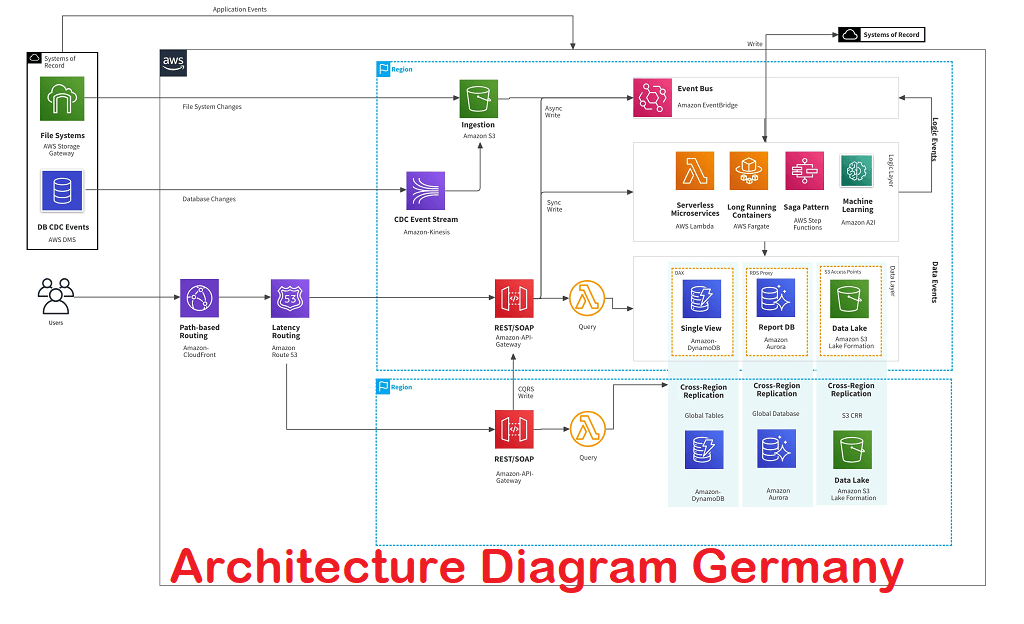Architecture Diagram Germany
Table of Contents
Toggle
Azure Architecture Diagram Germany
Azure architecture diagrams illustrate Microsoft Azure settings, describing elements such as Azure SQL databases, virtual networks, and subnets. For your Azure cloud projects, they function similarly to blueprints. They demonstrate how various Azure products work together to power your cloud. Your cloud needs a schematic, just like a house needs a plan.
Consider using Azure to create a website. A diagram would demonstrate how your website manages traffic, connects to users, and stores data. Using pre-made components that represent various Azure services, Cloudchart facilitates the creation of these architecture diagrams.
Consider Cloudchart to be your own cloud architect. You make the masterpiece; we supply the tools.
GCP Architecture Diagram Germany
The structure of your data and apps on the Google Cloud Platform can be shown visually with GCP architectural diagrams. They act as a roadmap, showing how Google Cloud resources and services are interconnected. [German Architecture Diagram]
These diagrams give you a thorough picture of your cloud infrastructure by graphically representing elements such as Compute Engine instances, Cloud Storage buckets, and Cloud SQL databases.
Let’s understand this with some real-world examples:
Online shopping Website: An online store’s GCP architecture diagram may illustrate how customer data is processed with Cloud Functions, saved in Cloud Storage, and delivered via Cloud CDN.
Data Analytics Pipeline: A graphic could show how information is gathered from multiple sources, processed with Dataflow, and then examined in BigQuery to produce insights.
IoT Application: A diagram might show how Cloud IoT Core is used to gather data from IoT devices, Cloud Pub/Sub is used to process the data, and Bigtable is used to store the data for real-time analysis.
By offering a comprehensive collection of GCP-specific icons and templates, Cloudchart streamlines the process and enables you to quickly produce diagrams of expert quality.
Common Software Architecture Patterns
Client-Server Architecture [Architecture Diagram Germany]
Assume you’re ordering pizza. You, the customer, are the client. The pizza establishment (the waiter) accepts your order, prepares the pizza, and delivers it to you. This is similar to a client-server setup.
In computing jargon, a client is your computer or telephone. It requests something, such as a web page or email. A server is a sophisticated computer that stores and distributes information. When you make a request, the server discovers the information you require and returns it to your device.
This is how most websites and internet services operate. Your computer is the client requesting information, and the website’s server delivers it. In essence, the client-server architecture splits tasks between the requester (client) and the supplier (server), increasing system efficiency and scalability.
Cloudchart can help you visualise this interaction by generating architecture diagrams that depict how clients and servers interact. Cloudchart’s shapes and lines can be used to depict various components and their connections, which makes complex systems easier to understand.
Service-Oriented Architecture (SOA)
SOA is similar to building with pre-made blocks. Instead of constructing everything from scratch, you use ready-made components known as services. These services provide specialised functions and can be coupled in various ways to create larger applications.
Imagine a restaurant. They have three sections: cooking, serving, and billing. Each section functions like a service.
These services work together to serve you a meal. In software, services can include checking a customer’s credit, calculating a total, and sending an email.
Benefits of SOA:
Reusability: Services can be utilised in a variety of applications.
Flexibility: You can replace or upgrade services without disrupting the entire system.
- Efficiency: The use of pre-built components saves time and resources.
Cloudchart can let you generate diagrams that demonstrate how various services interact. Shapes can be used to represent services, lines to indicate connections, and labels to describe what each service does. This allows you to better grasp the entire design and identify potential improvements.
You can use SOA and technologies like Cloudchart to create more complex and adaptable software systems.
